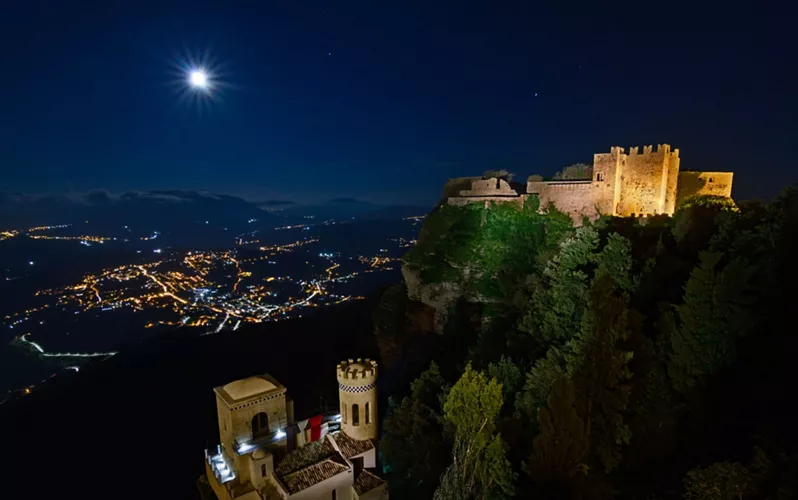This content was automatically translated. View the original text.

Overview
Erice, city of the goddess Venus
One of Sicily's most enchanting locations, Erice is like an eagle's nest from which to enjoy grandiose views of the Trapani coast to the Egadi archipelago.
Set on a cliff 751 metres above sea level, its curious triangular perimeter contains not only valuable medieval monuments and churches, but also a contemporary art centre and a prestigious scientific institution.
Erice is a jewel of art and culture with a millennial history that deserves to be visited at least once in a lifetime.
A treasure chest of artistic and archaeological treasures
The origins of Erice are ancient. They are traced back to the Elymians, a people of probable Greek origin who, according to legend, descended from Trojan exiles. Beyond the foundation myth, Erice was also known to the Romans for a sanctuary built on a steep cliff dedicated to the cult of the Greek Aphrodite and, later, the Roman Venus Ericina, goddess of fertility and love.
In the Middle Ages, the Normans built a manor in the same area. Known today by a name that sums up the entire history of the place, the Castle of Venus dominates the fortress and watches over the surrounding area.
The fortress is the highest point in Erice, and we recommend you choose it as the initial or final stop on your walk through the town of Erice. If you start from above, enjoy the splendid view of the coast and the delightful Torretta Pepoli. Through the Balio garden, you enter the elegant medieval old town with its carpet-like stone pavement and narrow alleys, because space within the walls has always been scarce. Not to be missed: the church of San Giovanni Battista with its round dome and pointed portal and some statues by the Gaginis, and the Antonino Cordici museum set up in the former convent of San Francesco and divided into several sections, which is fundamental to learn about the history of Erice.
Continuing towards Piazza Umberto you will find the Ettore Majorana Centre for Scientific Culture, in the former monastery of San Pietro, which hosts symposia and conferences dedicated to various scientific disciplines every year.
Towards Porta Trapani is the elegant Piazza Matrice with the 14th-century cathedral. Characterised on the façade by a rose window and preceded by a crenellated portico with pointed arch openings, it presents itself in all its medieval splendour. The neo-Gothic interior captivates with its elegance and the art treasures preserved there. Note the nine Greek marble crosses on the south wall affixed in 1685 and coming from the temple of Venus Ericina.
Beyond the Porta del Carmine along Via dell'Addolorata one arrives at the so-called Spanish Quarter, which is not a real quarter, but a building that was supposed to house Spanish troops but remained unfinished. Today, it is home to permanent anthropological exhibitions. From its terrace, the panorama will leave you breathless.
Trekking on Mount Erice
The amenity of the place is such that you will want to explore the area of Mount Erice. To do so, there are the Agro Ericino trails, various trekking routes that start mostly from the arrival of the funicular railway from Trapani to cross the state forest or to explore the three rock churches scattered around the mountain. Above Erice, there is also a CAI hut to which one can refer to explore the area and also go to Mount Cofano and San Vito Lo Capo.
Genovesi and martorana fruit: discover traditional sweets
If walking has made you hungry, there is no shortage of pastry shops in Erice where you can get refreshed. The town has a strong tradition of sweets, the recipes for which are said to have been handed down by the cloistered nuns of Erice,
the most typical of which are the genovese, a shortcrust pastry morsel filled with cream and eaten while still warm; mustazzoli, aromatic hard and crispy biscuits; ripostetti, filled with citron conserve and decorated with pastel-coloured icing; bocconcini di mandorla, quaresimali and frutta martorana.
The most renowned pastry shops are Maria Grammatico's, which also organises cooking courses, and San Carlo, both in the historic centre. Desserts go well with a glass of sweet Marsala from the vineyards cultivated just below Mount Erice.
91016 Erice TP, Italia